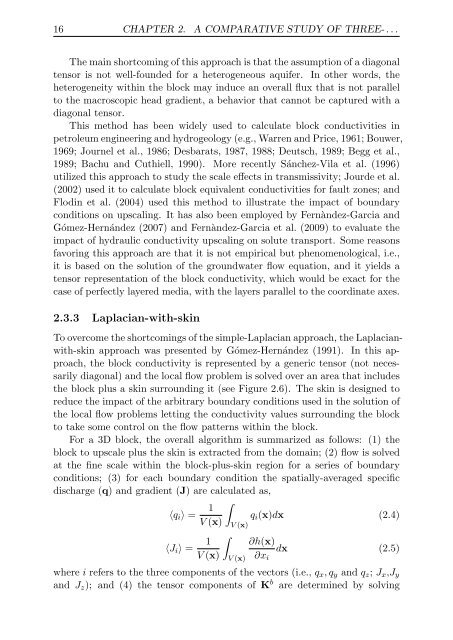Upscaling and Inverse Modeling of Groundwater Flow and Mass ...
Upscaling and Inverse Modeling of Groundwater Flow and Mass ...
Upscaling and Inverse Modeling of Groundwater Flow and Mass ...
You also want an ePaper? Increase the reach of your titles
YUMPU automatically turns print PDFs into web optimized ePapers that Google loves.
16 CHAPTER 2. A COMPARATIVE STUDY OF THREE- . . .<br />
The main shortcoming <strong>of</strong> this approach is that the assumption <strong>of</strong> a diagonal<br />
tensor is not well-founded for a heterogeneous aquifer. In other words, the<br />
heterogeneity within the block may induce an overall flux that is not parallel<br />
to the macroscopic head gradient, a behavior that cannot be captured with a<br />
diagonal tensor.<br />
This method has been widely used to calculate block conductivities in<br />
petroleum engineering <strong>and</strong> hydrogeology (e.g., Warren <strong>and</strong> Price, 1961; Bouwer,<br />
1969; Journel et al., 1986; Desbarats, 1987, 1988; Deutsch, 1989; Begg et al.,<br />
1989; Bachu <strong>and</strong> Cuthiell, 1990). More recently Sánchez-Vila et al. (1996)<br />
utilized this approach to study the scale effects in transmissivity; Jourde et al.<br />
(2002) used it to calculate block equivalent conductivities for fault zones; <strong>and</strong><br />
Flodin et al. (2004) used this method to illustrate the impact <strong>of</strong> boundary<br />
conditions on upscaling. It has also been employed by Fernàndez-Garcia <strong>and</strong><br />
Gómez-Hernández (2007) <strong>and</strong> Fernàndez-Garcia et al. (2009) to evaluate the<br />
impact <strong>of</strong> hydraulic conductivity upscaling on solute transport. Some reasons<br />
favoring this approach are that it is not empirical but phenomenological, i.e.,<br />
it is based on the solution <strong>of</strong> the groundwater flow equation, <strong>and</strong> it yields a<br />
tensor representation <strong>of</strong> the block conductivity, which would be exact for the<br />
case <strong>of</strong> perfectly layered media, with the layers parallel to the coordinate axes.<br />
2.3.3 Laplacian-with-skin<br />
To overcome the shortcomings <strong>of</strong> the simple-Laplacian approach, the Laplacianwith-skin<br />
approach was presented by Gómez-Hernández (1991). In this approach,<br />
the block conductivity is represented by a generic tensor (not necessarily<br />
diagonal) <strong>and</strong> the local flow problem is solved over an area that includes<br />
the block plus a skin surrounding it (see Figure 2.6). The skin is designed to<br />
reduce the impact <strong>of</strong> the arbitrary boundary conditions used in the solution <strong>of</strong><br />
the local flow problems letting the conductivity values surrounding the block<br />
to take some control on the flow patterns within the block.<br />
For a 3D block, the overall algorithm is summarized as follows: (1) the<br />
block to upscale plus the skin is extracted from the domain; (2) flow is solved<br />
at the fine scale within the block-plus-skin region for a series <strong>of</strong> boundary<br />
conditions; (3) for each boundary condition the spatially-averaged specific<br />
discharge (q) <strong>and</strong> gradient (J) are calculated as,<br />
⟨qi⟩ = 1<br />
∫<br />
qi(x)dx (2.4)<br />
V (x)<br />
⟨Ji⟩ = 1<br />
V (x)<br />
∫<br />
V (x)<br />
V (x)<br />
∂h(x)<br />
dx (2.5)<br />
∂xi<br />
where i refers to the three components <strong>of</strong> the vectors (i.e., qx, qy <strong>and</strong> qz; Jx,Jy<br />
<strong>and</strong> Jz); <strong>and</strong> (4) the tensor components <strong>of</strong> K b are determined by solving


